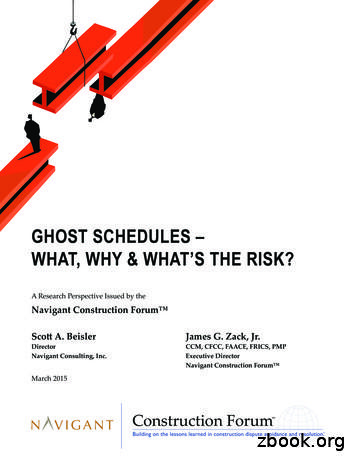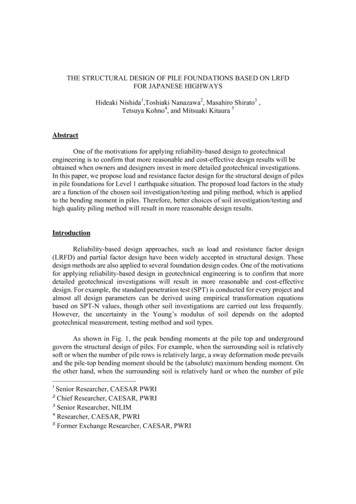Essential Guide To Ghost Kitchens - Guide Oracle
Essential Guide to Ghost Kitchens—CONSIDERATIONS FOR RESTAURATEURS
Essential Guide to Ghost KitchensOVERVIEWFor entrepreneurs juststarting, the ghostkitchen model providesa lower cost, faster timeto market option thanopening a full-servicerestaurant. For existingbrands, ghost kitchensprovide a lower riskmethod to expand intonew areas or test out anentirely new concept.Ghost kitchens are influencing and reshaping the food service industry. They enablebusinesses to start or expand a food business at minimal cost, leading to relativelyfrictionless scaling, and the opportunity to explore new concepts, virtual brands anddiversify.Many of the food companies running ghost kitchens are using them as an experimentalspace, optimizing staff and inventory while testing the market with fresh ideas.This incredible flexibility is unprecedented in the industry and could be its most profitableally. It allows businesses to diversify while cutting back their two biggest operational costbarriers – rent and labor. No servers, no uniforms, no furniture, soft-furnishings or otherexpensive décor just straight food service for a group of chefs and cooks delivering to theircustomers.This guide explores everything you need to consider when setting up a ghost kitchen orstarting a virtual brand. We hope you find it useful.
The Delivery MarketA recent report by UBS found that: The online food delivery market will grow 10 times in the next 10years, from 35 billion globally to 365 billion by 2030. Online food delivery is part of a mega-trend, combining the ondemand and sharing economies. There could be a scenario that most meals currently cookedat home are instead ordered online and delivered from eitherrestaurants or central kitchens.ONLINE FOOD DELIVERY TO GROW 10X BY 2030Source: UBS Report: Is The Kitchen Dead?
What is a Ghost Kitchen?Ghost kitchens provide the ‘kitchen’ piece of a restaurant operation without the on-premises diningor direct customer interaction - no host or wait staff and no cashier. The contactless customer modelfocuses on off-premises service only, delivered mainly via third parties, delivery aggregators and insome cases collection locations.Virtual KitchenCommissary KitchenDark KitchenGhost KitchenVirtual BrandCloud KitchenCyber Kitchen
Business ModelsType 1: Shared Space Ghost KitchenA shared space ghost kitchen operates out of a rented space which is already fully equipped withrestaurant appliances. It’s set up specifically for multiple ghost kitchens to simultaneously share the samespace. In some cases, the space may also come with pre-existing technology that a brand can use to hitthe ground running.DisadvantagesAdvantages Minimal (often no) equipment costReduced equipment cost means less risk ifthe venture doesn’t work outServices such as cleaning are often provided– providing understood labor costsTechnology is sometimes provided and maybe integrated with delivery services Month-to-month cost may be higher in the longterm compared to a bulk up-front costRestaurants must use what is in the space –cannot move/sell equipmentLikely cannot have a customer space for orderpickup; all orders will go through delivery
Type 2: Dedicated Space Ghost Kitchen (Dark Kitchen)A dedicated space ghost kitchen is a new or existing kitchen that has been rented (or purchased) by abrand solely for its own use. The brand may decide to put one concept or several different concepts inthe one location, but it doesn’t have other brands operating out of that space.Advantages Can control the brand message, look and feelCan change equipment and move thingsaround as neededCan have space for customers to pick up ordersCan control who goes in and out of the spaceCan decide what technology to useDisadvantages High start-up costsYou need to purchase your own equipmentHigh risk for non-established brandsMedium risk for established brands, which canbe mitigated with good research
Type 3: Virtual BrandA virtual brand allows you to diversify your offering and reach new customers. Creating a virtual brandmeans using your existing kitchen, equipment and supplies, under new branding, to test out a newconcept or cuisine without heavy investment.This gives you an opportunity to: Develop new ideas and new concepts under a new brand name with lower risks and costs Reduce food wastage in your kitchen Test new dishes and styles before adding them to your established brand menuAdvantages Minimal start up investmentUtilize existing kitchen spaceMay already have equipment or canrepurpose existing equipmentLow risk – if it doesn’t work out, you canshut down the operation without worryingabout rent and selling equipmentDisadvantages May take up valuable space in a crowdedkitchenNeed to be able to effectively separate outthe reporting of multiple concepts to properlyevaluate the profitabilityNo foot traffic – to avoid branding confusion,operation is done as delivery-only and maybe hard to promote, resulting in additionalmarketing costs
Do Your ResearchKnow Your DemographicOpening a new business can be overwhelming and making sure you do your research ahead of time is very important to thesuccess of the business. Here are some ideas to help you get started:Research the demographic of your customer and where you plan on selling. This should allow you to see a few key pointsabout who you’ll be selling to. Some of these points include: Will my concept appeal to the local market? If the answer is yes – is the market already saturated with the concept? What is the age demographic? Should you consider taking phone orders rather than orders via a mobile app? Should youoffer kid-friendly menu items/sizing?Know Your Location Where can you deliver to? Does this restrict or change any of the aforementioned topics? If you have options for take-out, does the neighborhood look nice/safe/appeal to your audience? If you decide to expand, how will you go about it? Does your space come with equipment? If so – are you able to add more if needed? If not, what kind of equipment shouldyou purchase?
PackagingNo matter how good your food is, if it’s not packaged well,it can ruin the customer experience and damage yourbrand reputation.In a delivery-only restaurant business, the food you serve remains one of the main parameters to differentiate your brandfrom the rest. However, the packaging of food is important as it captures the attention of customers and creates a desirablebrand perception.No matter how good your food is, if it’s not packaged well, it can ruin the customer experience and damage your brandreputation. Not only is it important for the food packaging to be cost-effective and functional, but the food presentation mustalso align with customer expectations.Packaging also depends on the type of food you’re serving. Apart from being aesthetically pleasing, the primary purpose ofpackaging is to protect food from contamination, maintain the right food temperatures and prevent it from spilling duringdelivery. When done right, packaging helps you uphold the standard of quality you want to be known for and uplifts the overallexperience for customers.You should also consider environmentally friendly and sustainable packaging, if that’s in line with your brand values. It’s also agreat way to communicate to your customers that you care about the environment.With growing concern about the environment and the use of recyclable material, food packaging has become more green. Youcan eliminate single-use plastics and switch to biodegradable, recyclable, or reusable packaging.
StaffingThe secret sauce behind a successful restaurant is the team, the chef being the most critical part of the team, as they not onlyprepare the food but also help in designing the menu.Since there is no front of house, you don’t need a large staff in your cloud kitchen. You can easily open your business with 2-3staff who’d be focused on processing orders, preparing and delivering the food.Third-party delivery aggregators such as Uber Eats, DoorDash and Deliveroo, provide the technology for taking orders online,which means you don’t necessarily need to have your own online ordering system - this can save you time and money inthe short term. One draw back is that these delivery services charge a commission on a per order basis, reducing your profitmargin.It’s important that you weigh up the costs of partnering with delivery apps, versus the costs of hiring your own staff fordelivery, and having your own system for taking orders, either online or over the phone. You’ll need to factor in the costs ofsetting up your own online ordering platform, which might mean a financial outlay in the short-term, but a more cost-effectivesystem long term, depending on the fees charged by delivery providers and how many of these providers you choose topartner with.
HOME For take-out it’s crucial to limit your delivery menu toabout 12 items or less, enabling the customer tomake a quick decision. If you operate within anexisting dine-in restaurant, you may want to considerrefining your full menu offering.
Menu DesignWhen designing new menu items to better serve delivery and take-out customers, you need to consider the portability of theitems on your menu, whether they will hold heat well, and be durable in transportation.Avoid or alter food that will become soggy or wilt and steer clear of combinations that will mix or mash together duringdelivery, such as sauce and purees.You may need to look at the time and distance the food is travelling and set limits, for example to ensure food quality ispreserved you may only deliver certain items within a 15-20 minute radius.In preparing menu items for delivery, you need to think about the components within a dish that may need adjusting in adelivery and to-go order. For example, you may need to package dressings and sauces in separate containers. Or you maywant to provide the special sauce to the top of your signature burger in a separate container, rather than directly to the burgerbun. This will allow the meal to keep better during delivery.For take-out it’s crucial to limit your delivery menu to about 12 items or less, enabling the customer to make a quick decision. Ifyou operate within an existing dine-in restaurant, you may want to consider refining your full menu offering.Make sure the recipes are profitable - items that are high on carbohydrates and low on protein make good money – it’s noaccident that pizza, rice and noodles are popular for delivery. If you’re using a third-party delivery service, it’s essential thatyou have a very good margin in every item.
Choosing the Right Tech StackTechnology plays a crucial role in ghost kitchens, asmost orders are made online through a website, mobileapp or delivery aggregators. A ghost kitchen requires anintegrated technology system for accepting online orders,processing payments, and efficient kitchen management.Point of Sale (POS)A key requirement for a ghost kitchen is a point-of-sale (POS) system that accepts orders from various channels, such asdelivery aggregators and online ordering platforms. Having a POS system that is open to integrations with third party solutionsincreases efficiency as orders coming through different channels don’t need to be manually entered into the POS terminal.This not only saves time and reduces the risk of errors, it also means you cut down on your labor costs.Reporting and AnalyticsHaving access to powerful reporting tools is key to running a successful ghost kitchen or virtual brand - it gives you valuableinsight into what’s actually happening in your business so you can make quick decisions that will impact your bottom line.From making sure you have the right number of staff, to reducing waste through effective stock management, to designing aprofitable menu and easily identifying your top sellers - having the right reporting tools will help keep business costs in checkand profits flowing.
Delivery AppsThe most important role in the advent of ghost kitchens has been played by food delivery services. With services like Uber Eats,DoorDash and Deliveroo, food has become available in just a few clicks. These services will charge you between 15% and 35%commission. You’ll need to weigh up the money you spend in commission fees versus the order volumes generated by theseservices.So how do you connect to delivery apps? Technology that employs open integration to other solutions will help you adaptquickly to changing business needs and new customer trends, such as delivery. Having an open-integration POS platform willallow you to connect quickly and easily to delivery apps and streamline your processes to ensure service is fast and foodquality isn’t compromised.While partnering with online delivery aggregators is an important consideration, it’s also worthwhile to think aboutimplementing your own restaurant website or mobile app for accepting orders, as an additional sales channel.Inventory ManagementEffectively managing inventory is essential for any restaurant, and the same stands true for a ghost kitchen. A smart inventorymanagement system enables you to track daily stock consumption and prompts you to order more stock when needed. It helpsyou reduce waste, keep control of your food costs, and enhance menu profitability.Kitchen ManagementIn a fast-paced ghost kitchen, order preparation time is usually around 10-12 minutes, if you want to deliver the order within 30minutes. An integrated Kitchen Display System (KDS) will optimize order preparation time.As soon as the order is received, it’s instantaneously updated in the KDS. Kitchen staff can view the order details and the orderpickup time immediately and prepare the order accordingly. This streamlines kitchen management maximizes efficiency andenables you to identify any lags to further optimize the preparation time.Having a comprehensive technology platform with seamless integration between POS, online ordering platforms, KDS andinventory management will ensure operational efficiency and the smooth functioning of your ghost kitchen.
Customer Loyalty & MarketingFor a ghost kitchen, marketing is critical as it’s the single source of building awareness and generating orders. Since you’re notspending money on setting up a brick and mortar restaurant with expenses such as fit-out, furniture, decorations and front ofhouse staff, you can set aside some funds for marketing.Online marketing works in favor of ghost kitchens. The first thing you need to do is to get your business registered onrestaurant listing and review sites, such as Zomato and Tripadvisor, and encourage positive reviews from your customers. It’snot only important to get reviews, but also to consistently monitor them and respond where appropriate. Immediate feedbackcan make customers very happy and builds trust with your brand. It also gives you the opportunity to respond quickly to anynegative reviews and to turn the customer around.Advertising on social media is also effective, especially for exclusive deals and discounts for your followers. These social mediaplatforms allow you to target by demographic and location to ensure you’re reaching the right audience. You can set dailylimits on your advertising in order to ensure you stay within your budget. Graphic design platforms, such as Canva, make itquick and easy to create eye catching social posts and offer basic functionality for free.You may also consider distributing flyers around your local area as a way to spread the word. However, you’ll need to considerdesign and printing costs.Once you start selling your dishes, you want your customers to keep coming back. Incentivizing them with promotional offers,loyalty rewards, discounts on future orders, or deals on special days (holidays, birthdays, etc.) is a great way to increasecustomer loyalty.Retaining customers is far more valuable and cost-efficient than recruiting new ones. Having the right software to manage aloyalty program can help you drive repeat business. A loyalty solution allows you to build a customer database so you can seepurchase history and keep your customers engaged with promotions and rewards that are relevant to them.
About Oracle Food & BeverageBy pioneering hospitality IT innovations in hardware and software for more than 40 years, Oracle Food andBeverage has become the industry’s preferred solutions provider. We deliver best-in-class cloud technology —backed by trusted support and consulting services in a true partnership — to help food and beverage operatorsenhance the guest experience, increase revenues and reduce costs.Book your free tour of the ghost kitchen technology stackReach out directly by phone US: 1 866-287-4736; UK: 44 207 5626 827; AU: 1300 366 386;LAD: 52 559 178 3146 by chat or submit an online inquiryOracle CorporationWorld Headquarters500 Oracle ParkwayRedwood Shores, CA 94065U.S.A.Find your local Oracle contactnumber obal-070511.htmlCopyright 2020, Oracle and/or its affiliates. All rights reserved. This document is provided for informationpurposes only and the contents hereof are subject to change without notice. This document is not warrantedto be error-free, nor subject to any other warranties or conditions, whether expressed orally or implied inlaw, including implied warranties and conditions of merchantability or fitness for a particular purpose. Wespecifically disclaim any liability with respect to this document and no contractual obligations are formedeither directly or indirectly by this document. This document may not be reproduced or transmitted in anyform or by any means, electronic or mechanical, for any purpose, without our prior written permission.Oracle and Java are registered trademarks of Oracle and/or its affiliates.Other names may be trademarks of their respective owners.
Type 2: Dedicated Space Ghost Kitchen (Dark Kitchen) A dedicated space ghost kitchen is a new or existing kitchen that has been rented (or purchased) by a brand solely for its own use. The brand may decide to put one concept or several different concepts in the one location, but it doesn't have other brands operating out of that space. Advantages
The term "ghost kitchen" has surged in popularity over the past year. In this rst section of The Beginner's Guide to Ghost Kitchens, we outline what a ghost kitchen is and what sets it apart from the rest of the dining industry. A ghost kitchen is a food facility that operates exclusively for online and delivery orders.
are a stupid ghost. The least a ghost can do is to read a man’s thoughts. However , a worthless ghost like you is better than no ghost. The fact is, I am tired of wrestling with men. I want to fight a ghost”. The ghost was speechle
Nov 07, 2021 · Tues. & Thurs. 5:30 pm Holy Ghost Wed. & Fri. 8:30 am Holy Ghost Weekend Saturday 5:00 pm Holy Ghost Sunday 8:00 am Holy Ghost 9:30 am St. Bridget 11:00 am Holy Ghost
vending locations. Examples of commissaries include, but are not limited to, vending company . production kitchens that prepare food for use in vending machines; senior citizen meals production kitchens that deliver either frozen or ready-to-eat meals; kitchens that prepare food for small boat day trips; kitchens located at an event hall or .
Gerald Massey's “ Book of.the Beginnings,” 338, 415 Ghost at Noon-day, 321 Ghost—The Gwenap, 268 Ghost—The Micklegate, 23, 60 Ghost-seeing, in North American Review, 307 Ghost, Solitary Visit by a, 367 Ghosts by Day, 350 Ghosts in Africa, 33 Ghosts, The Truth about, 325, 343 Ghosts,
the term Ghost Schedule. It is prudent to discuss what a Ghost Schedule is not. A contractor's Ghost Schedule is not a schedule maintained in lieu of submitting a baseline schedule and schedule updates per the contract. Even if the contractor is using a Ghost Schedule, it still must comply with the contract's scheduling requirements. An .
Green: ghost solid. 4 The Ghost SPH Method 4.1 Algorithm Overview We solve the particle deficiency at boundaries and eliminate arti-facts by (1) dynamically seeding ghost particles in a layer of air around the liquid with a blue noise distribution, (2) extrapolating the right quantities from the liquid to the air and solid ghost parti-
in pile foundations for Level 1 earthquake situation. The proposed load factors in the study are a function of the chosen soil investigation/testing and piling method, which is applied to the bending moment in piles. Therefore, better choices of soil investigation/testing and high quality piling method will result in more reasonable design results. Introduction Reliability-based design .























